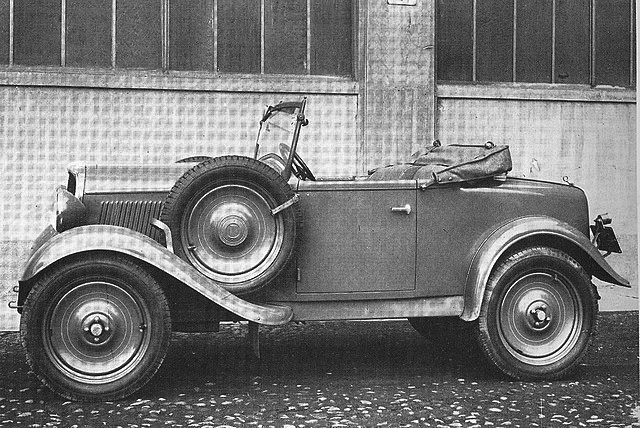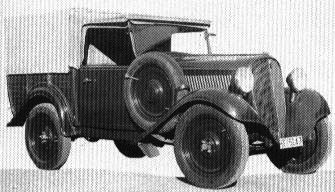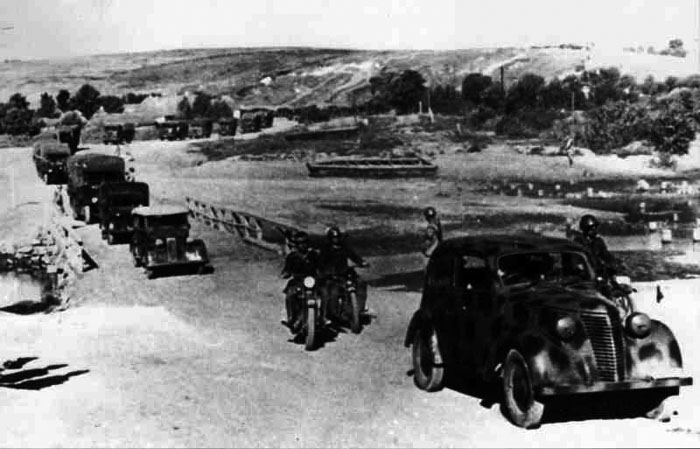FIAT 508CM
 Italy (1937) - Staff Car- 6,000 built
Italy (1937) - Staff Car- 6,000 built
As with the Aprilia, the FIAT 508 Torpedo Coloniale also derived from a production car, the 508 C, better known as "Balilla". The 508CM was mainly used as staff car in North Africa. Robust, it was also suitable and sued for off-road reconnaissance with higher axle ratio and larger tires (6.00 x 16) slightly longer chassis but greater weight at 1,200 kg. It was an interwar precedessor of true utility 4x4 vehicles such as the Jeep 3 years later. The CM was produced to around 6,000 vehicles and remained in service until 1960.
Origins: The Ballila
About the Fiat 508 and 508M Balilla
 The 508 S Balilla Berlinetta Mille Miglia
The 508 S Balilla Berlinetta Mille Miglia
The 508 was a popular new model designed by several famous motoring figures such as Tranquillo Zerbi, Antonio Fessia, Bartolomeo Nebbia and Dante Giacosa which produced a small vehicle with good overall performance and still at relatively low costs. The model was presented at the Milan Fair on 12 April 1932 Motor Show and sold at 10,800 lire of the time. Compact at 685 kgs, it was declined in a large variety of bodies and chassis, declined into tailored bodies as well. But it remained purely civilian.
 The 508 Balilla Spider Militare, 1932
The 508 Balilla Spider Militare, 1932
 The 508M Camioncino
The 508M Camioncino
The 508M was Fiat's answer to a tender of 1931 for a light, tactical, liaison and reconnaissance vehicle. In 1932 FIAT presented a spider (two-seater) variant at the Milan Motor Show and while the normal sedan version was also adopted. Declared the winner, it was adopted in 1933. However the same yer, the Camioncino version was developed as light artillery towing vehicle. In 1934 the 2nd series appeared, derived from the Fiat 508B in a 4-seater torpedo version. It was declined into the 508M was still a nimble vehocle at 3,25 m x 1,38 m x 1,45 m and 690 kg powered by the 108 C, 4 cyl. gasoline 995 cm³ Fiat engine that developed 30 CV (22 kW) a 4,400 rpm. This 4×2 could reach up to 65 km/h on flat and had a range of 310 km, could negociate a 30% slope and had an excellent acceleration.
 Fiat 1100 Coloniale
Fiat 1100 Coloniale
It was deployed in the Ethiopian War, showing fragility in its suspensions, which needed to be modified. It was also widely used during the Spanish Civil War, but production was stopped in 1937 when replaced by the 508CM and military version of the Fiat 1100.
A new staff car for the Army
The Fiat 508CM was a militarized version of the Fiat 1100 presented in 1938 at the Centro Studi Motorizzazione. It derived from the Fiat 508 C torpedo militare and was tested in 1937, partly based on the experience of the Ethiopian war. It was produced until 1939. The 508CM was staff, command and reconnaissance car, more appropriate for all terrains. Unlike the much larger Alfa Romeo 6С2500 Coloniale or Lancia Aprilia Coloniale.
It was light, nimble, agile, simple and robust, but also quite fast on the road and inexpensive to purchase and maintain. Compared to the civilian 1100 it had a more resistant, raised chassis, as well a better suspension. The "coloniale" version was developed with three different bodies and great care was brought to sealing, to avoid sand infiltration. There was also a 70 liter gasoline tank, larger than usual, and even wider tires compared to the 508M. The "Coloniale" ("C", and "M" for "Militare") received a lighter pain, Colonial "Nocciola", differing from the Grigio Verde livery of the 508CM.
Design
The 508CM is built on the chassis of the Fiat 508C. The chassis kept four 6.00 × 16 oversized tyres and with a design made for rocky or sandy terrains. It was a rear-wheel drive, right-hand steering wheel, slightly longer than the Ballila, with reinforced chassis, greater ground clearance and stronger lef spring suspension as well as a higher axle ratio. The body was that of a four-door torpedo (open), with square shapes for mass production, characteristic round grille, stamped doors, built-in steps, and spare wheel mounted on the back tail.
There was also a folding canvas folded behind the rear seats. The engine was the same Fiat 108C 1089 cm³ overhead valve 4-cylinder petrol engine which delivered 30 HP at 4,400 rpm. It was coupled with a 4-speed gearbox plus reverse so the vehicle, light, could reach for some sources up to 95 km/h (however the most common figure in battle order was c60 kph on road). At the factory, the vehicle was delivered in light grey-green (grigioverde claro) livery, often camouflaged in the field depending on the theater.
Variants
Fiat 508CM Pickup Truck
Fiat 508CM Sedan FO

508CM FO Berlina
The Eastern Front Sedan version saw 50 produced for the Italian Expeditionary Force participating in Operation Barabrossa in the summer of 1941. Tailored for the cold, it had an enclosed sedan-type bodywork and heating system. However they were soon lost in action and more and more standard 508CM were sent in complement in Russia. The second popular enclosed staff car was the Alfa Romeo 6C 2500 Coloniale, but again, not enough were made.
Operational use
 Erwin Rommel reviews the Italian Army, the forward section of a Fiat 508CM is visible in the right bottom corner
Erwin Rommel reviews the Italian Army, the forward section of a Fiat 508CM is visible in the right bottom corner
First public presentation took place in Avezano on July 11, 1938. Then, a group paraded in an all Fiat military vehicles during the inauguration of the Mirafiori center on May 15, 1939. The Fiat 508CM were versed to command staff of motorized units from 1938 onwards, in the colonies. In 1943, whe the production stopped, 6,000 had been made. They had been used on all fronts where the Italian army was present, from North to East Africa in 1940-41, the Balkans and Russia, including the special 50 made CSIR vehicles present in December 1941. This Fiat berlina FO (Oriental Front), differed by its fully enclosed passenger compartment and internal heating. But standards Fiat 508CMs were also used and a few hundred were still made in Italy for the Germans after the armistice.
The 508CM became the most widespread reconnaissance and liaison vehicle in the Royal Army during the Second World War. Produced until 1943 (after afterwards for the Germans), it really was the equivalent of the German Kubelwagen, but never was in sufficient quantities, despite being the most produced staff car. As stated already it soldiered everywhere between East Africa and Libya, the Balkans and the Eastern Front, Sicily and Italy. The remaining vehicles served until 1960 with the new Republican Army.
Fiat 508CM specifications |
| Dimensions | 3,615 x 1,482 x 1.48 m (soft top 1,922 m) |
| Total weight, battle ready | 890 kg |
| Crew | 4 |
| Propulsion | Fiat 108 4-cyl. in-line 1089 cm³, 30 HP 4400 rpm |
| Top speed | Up to 90 km/h |
| Transmission & suspension | 4×2 leaf springs |
| Maximum range (on/off road) | Fuel 23 or 70L, 323 km |
| Armament | None, personal weapons |
| Production | 6000 |
Links about the 508CM
italie1935-45.com
esercito.difesa.it
museomemoriale.com
vipiu.it
508 CM on wikipedia.it
508M on wikipedia.it
508 on wikipedia.it
Gli Autoveicoli tattici e logistici del Regio Esercito Italiano fino al 1943, vol. II, Stato Maggiore dell'Esercito, Ufficio Storico, Nicola Pignato e Filippo Cappellano, 2005.
Gli Autoveicoli del Regio Esercito nella Seconda Guerra Mondiale, Nicola Pignato, Storia Militare.